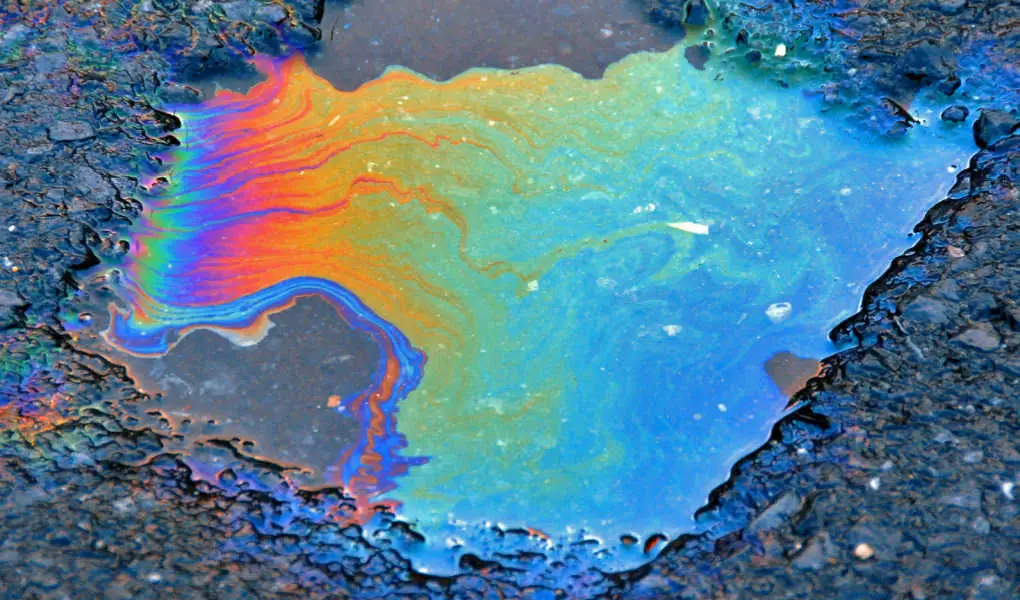Unfortunately, the biological information war is slowly making its way into our backyards and now is the time to prepare accordingly. If you’re awake and paying attention, you are taking the necessary steps to protect your health and body. One of the best ways of preserving your health is by using one of the water filtration systems listed below.
mRNA Vaccine Waste in the Water Supply
In our inner circle, people are now looking for the best water filtration systems to remove natural and synthetic mRNA, chemicals, and God only knows what else from our drinking water.

In the past year or two, like a lot of people, we have grown more concerned about our drinking water. Although we always carry a water filter, it was a piece of gear tucked away to be used in emergencies only. Sadly, human-engineered pathogens and biological disasters have pushed water safety to the forefront of many people’s priorities.
💧 Here’s Our SimPure Countertop Water Filtration System > Buy Now
Why Are the Non-injected Getting Sick From the Injected?
Much of this pursuit of clean drinking water started when we began questioning the following scenario:
- There are two healthy people.
- One of them gets injected with an mRNA vaccine.
- The person injected gets sick (even though the mRNA vaccine does not contain the virus).
- The non-injected person spends time with the injected and also gets sick.
While the non-injected are generally not getting as sick as the injected, one has to wonder why the non-injected are falling ill. The following research article highlights the reasons.
Critical read: Current knowledge on the excretion of synthetic mRNA and spike produced by mRNA vaccines.
Easy Reference Guide to mRNA Size
In easy-to-understand terms, here is the size of the SARS-CoV-2 particle, a spike protein, and the pore size of an RO membrane, respectively:
- SARS-CoV-2 diameter: 100 nanometers (0.1 microns)
- SARS-CoV-2 spike protein length: 10 nanometers (0.01 microns)
- The typical pore size of RO membrane: 0.1 nanometers (0.0001 microns)
To clarify, a SARS-CoV-2 virus particle is about 1000 times larger than the pore size of an RO membrane. More importantly, the SARS-CoV-2 spike protein is around 100 times the length of the RO pore diameter. This means that intact spike protein molecules will struggle to pass through an RO membrane.
💧 Best Water Filtration Systems For Travel and Home 💧
🌍 Families across the country are taking action by installing residential water treatment systems in their homes. While this article will explore the best water filtration systems in detail, the summary below offers a quick glimpse of some of the top options available (non-whole house systems). We’ll discuss each of these options in greater detail below.
- 🔹Overall RO Filter System: Waterdrop RO Reverse Osmosis Water Filter
- 🔹Tankless RO System: Waterdrop RO Reverse Osmosis Water Filter
- 💲Traditional RO System on a Budget: Express Water RO5DX Reverse Osmosis Filtration System
- 🏠RO For Countertops, RVs, and Apartments: SimPure Y7P UV Countertop Reverse Osmosis System
- 💧RO System for Quality Drinking Water: Express Water UV Reverse Osmosis Filtration System
- 🌲Survival/Outdoor/Travel Filter (non-RO): Survivor Pro Filter
- 🚰Tap Filter (non-RO): Sawyer Tap Filter
BEST WATER FILTRATION SYSTEMS
Water Quality in the USA is Deteriorating
Water Filtration Methods
Best Water Filtration Systems
Challenges to Filtering Water
With Filtration, Size Matters
All These Purification Methods—What’s the Difference?
Reverse Osmosis – The Best Method. Period.
The Fall of Berkey
Distillation
Low-tech Options
Water Quality in the USA is Deteriorating
Among the global backpacking community, the agreed philosophy was that if locals drank tap water, then generally it was safe for human consumption. Conversely, the rule of thumb was if the surrounding community used bottled water, so should you.
During our travels, there were only a few countries where we avoided drinking tap water including India, Thailand, Malaysia, and Albania.

It wasn’t until we spent an extended time in Arizona that reality set in that there are parts of the U.S. that do not have access to tasty, clean tap water. Moreover, it was shocking for us to learn that Arizonans typically don’t drink water directly from the tap. To illustrate, all the rental homes we stayed in were outfitted with various water filtration systems.
During this time in Arizona, we started learning more about the best water filtration systems and how to remove chemicals and mRNA from the drinking water.
Water Filtration Methods
Before we begin, let’s address the most common methods of water filtration. One of the challenging aspects of researching options is that the marketing game influences the available information. That is, every company wants to convince you that they offer the best way to purify your home’s drinking water. Regrettably, this is not for your well-being but rather to generate profits.
Generally, there are several common methods to purify water, including:
- Basic filtration
- Chemicals (e.g., chlorination or iodine)
- Boiling
- Ion exchange
- Distillation
- Carbon/charcoal filtration
- Reverse Osmosis (RO)
mRNA Vaccine Waste in the Water Supply > Best Water Filtration Systems
While some households can manage the expense of installing costly whole-house water filtration systems, this post also features options for families and travelers on a budget. Additionally, several different options are discussed—because in these trying times having choices makes staying healthy—and safe—a whole lot easier.
Of course, the best water filter will depend on what you want to remove from the water.
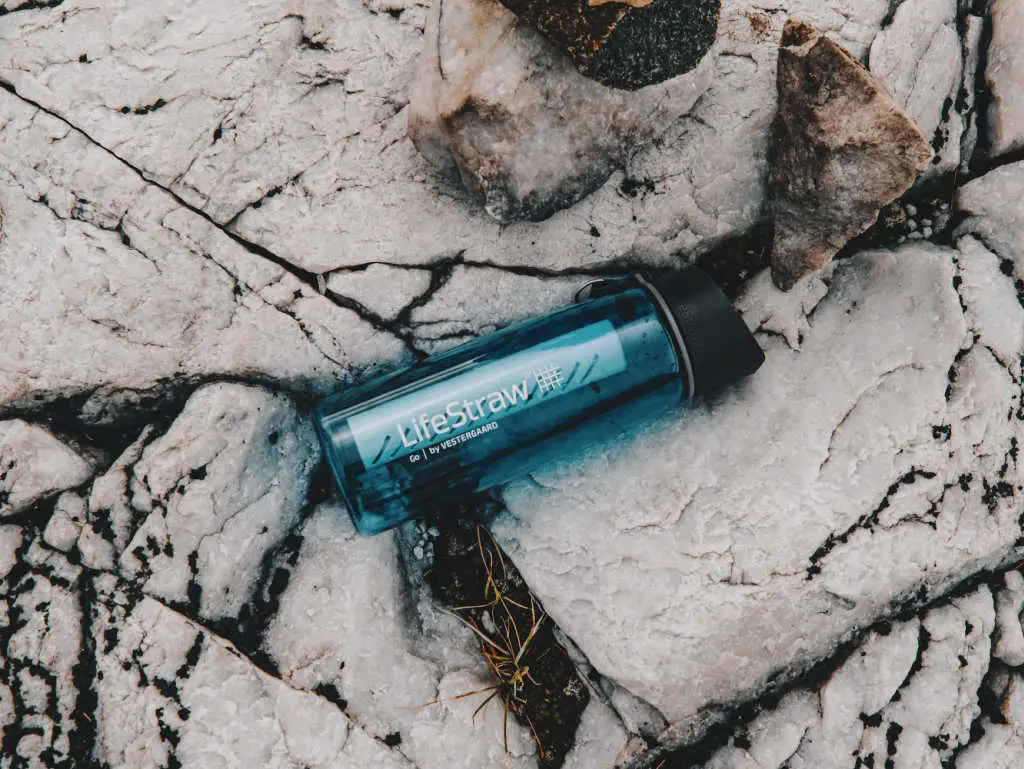
For example, Sawyer and LifeStraw filters are geared toward outdoor/survival situations. These product lines focus on removing harmful pathogens from questionable water sources.
There are also countertop and under-sink filters that supply clean drinking water. However, these only provide filtered water through one source, not the entire house.
A TDS water tester is a great tool to measure the impurity levels in your water, both before and after filtering.
Alternatively, another range of filtration focuses on home systems, such as cleaning municipal tap water or filtering private well water. Filtration systems for the home share a common goal to remove fluoride, dissolved solids, and microplastics from drinking water.
These substances are filtered in varying degrees through reverse osmosis, distillation, and ion-exchange water pitchers.
Challenges to Filtering Water
Unfortunately, many people get overwhelmed when considering a water filtration system for a few reasons. First, setting up a treatment system for a home is costly. Second, systems need regular filter replacement and ongoing maintenance.
It becomes problematic when you independently set up a home system, only to see that the replacement filters required are out of stock.
Let’s also address the compulsivity and obsessiveness when going down the research rabbit hole. I’m aware because I’m guilty of it myself. Sometimes, you need to take a deep breath and realize that you can only do, the best you can, at this point in your life.
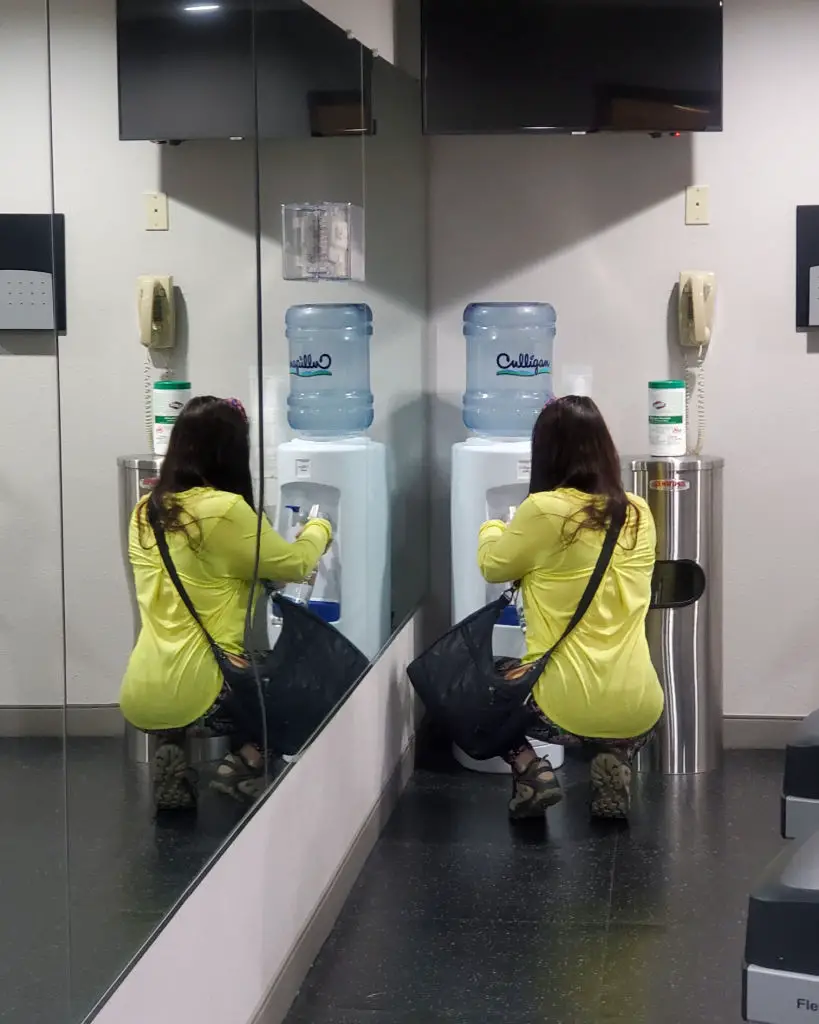
Meaning, if you can’t afford an expensive home system then settle for a countertop filter. If purchasing filters is too overwhelming, then explore low-tech options such as buying 5-gallon water jugs from a grocery store. Remember, doing something is better than doing nothing.
With Filtration, Size Matters
There are a few filter companies that are extremely popular among Americans. Each brand claims that they sell the “best water filter.” Below, are some of the most popular non-whole house water filters on the market.
A micron (μm) is equivalent to a millionth of a meter. Red blood cells are about 10μm in diameter. Just remember the golden rule—the finer the filtration, the better the water quality. Also, some level of filtration is always better than none.
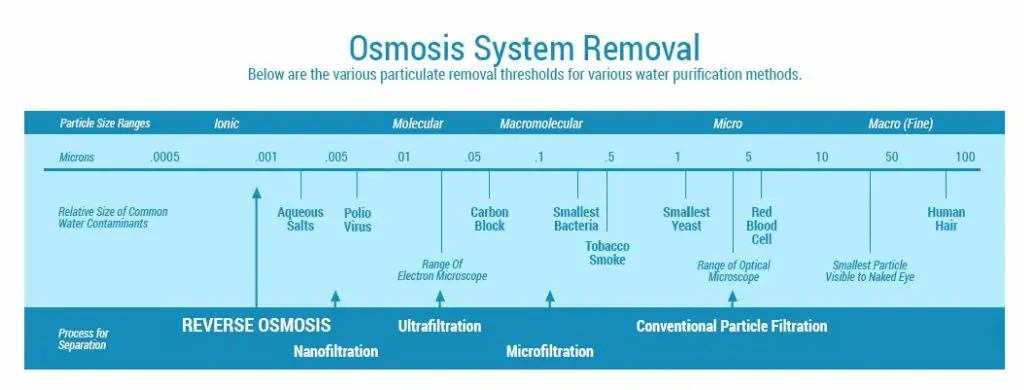
Naturally, each company’s website offers thorough testing reports from third-party organizations. There are charts, graphs, and data points showing how the products reduce various degrees of contaminants. These include substances such as heavy metals, fluoride, sediments, chemicals, pharmaceuticals, dissolved solids, microplastics, viruses, bacteria, etc.
All These Purification Methods—What’s the Difference?
Let’s take a look at what is removed during each purification process, briefly outlining the positives and negatives.
Conventional Particle Filtration – 1 Micron and Larger
The goal of conventional particle filtration is to remove larger particles like sand, rock, silt, larger clay minerals, larger protozoans like Giardia cysts (8 to 12 microns), Giardia trophozoites (10 to 18 microns), Cryptosporidium oocysts (4 to 5 microns). It does not remove viruses, bacteria, clay particles, or asbestos.
Example brands: ZeroWater, Epic Nano Filter, Brita, and PUR.
ZeroWater Filters
Many Americans swear by their ZeroWater pitcher filter, especially to clean out dissolved solids like calcium, sulfates, and phosphates. Some claim that the company “has a lot of balls” to include a total dissolved solids (TDS) meter with the pitcher.
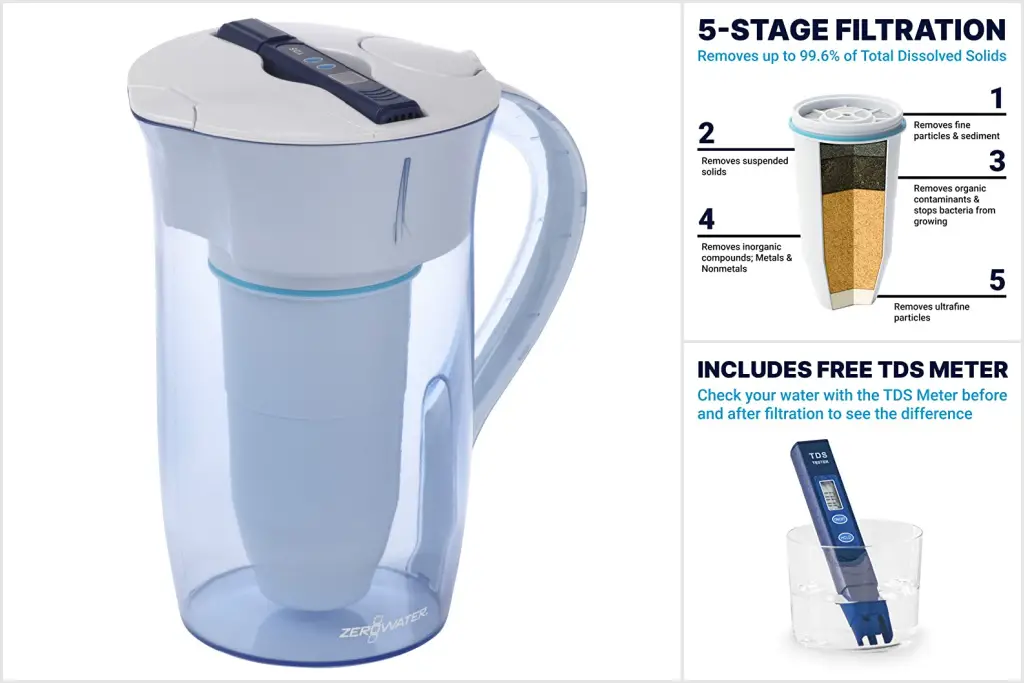
While to some degree the ZeroWater hype is warranted, filters are pricey and don’t last very long. For example, with heavy use or with hard water, users report replacing filters about every month or so. Also, the particle removal threshold is only 1 micron or 1μm.
Microfiltration – From 0.1 Micron to 1 Micron
The goal of microfiltration is to remove protozoa, cysts, and bacteria. The filtration is not fine enough to remove the following: all viruses, fine clay particles, salts, asbestos fibers, dissolved solids, colloidal silica, chemicals such as lead, chlorine, nitrates, colorings like tannins or chlorophyll, sugar, electrolytes, or even coffee.
The majority of LifeStraw products for personal use are microfiltration with an absolute pore size of 0.2 microns. The Alexapure Pro Water Filtration System is designed to filter particles down to 0.1 microns.
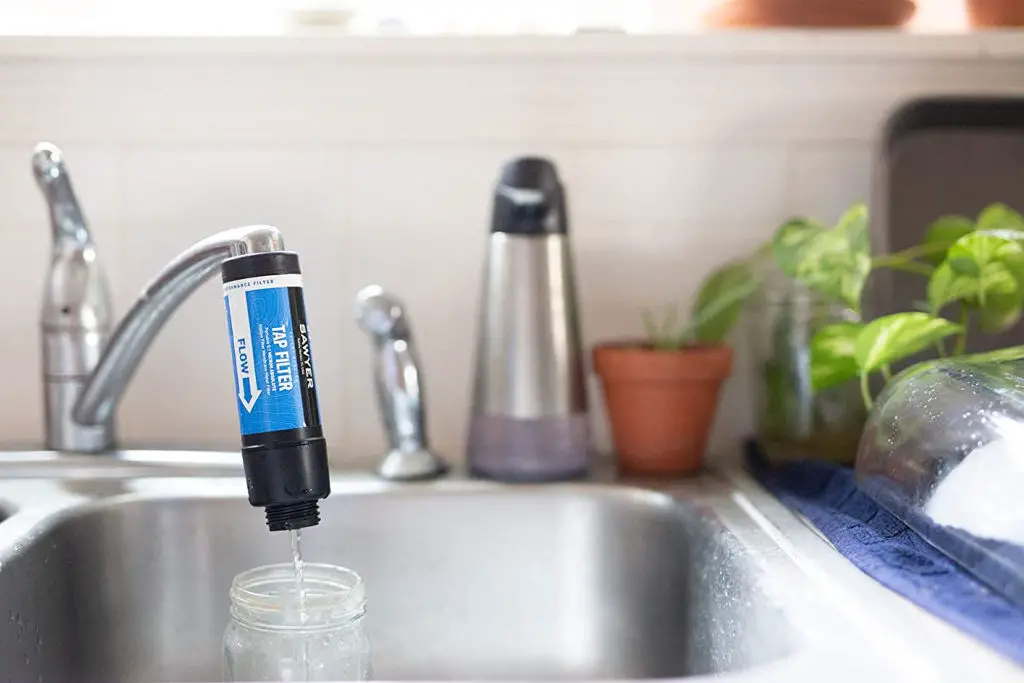
Also using microfiltration, The Sawyer Tap Filter will remove microplastics that cause reproductive and neurological diseases and is known to reduce testosterone levels. It has a 0.1-micron absolute filter.
Example brands: LifeStraw, Sawyer Tap Filter, Alexapure Pro Water Filtration System
Sawyer Tap Filter
For full disclosure, when we don’t have access to an RO water supply, we use a Sawyer Tap Water Filter, which removes 100 percent of microplastics from our water. Also, it can filter about 500 gallons of water per day and lasts up to 100,000 gallons.
Also, we carry a Sawyer One Gallon Gravity Water Filtration System w/Dual-Threaded Mini Filter in case of emergency. You can drink swamp water with this little gadget. However, in light of new information regarding the bioengineered waste from the “vaccine” in the water supply and biological disasters, we will upgrade to a new system.
Ultrafiltration – From 0.5 Micron to 0.01 Micron
At this size, filtration membranes block all bacteria, protozoa, microplastics, and most viruses, silica, proteins, and endotoxins.
Example brand: Survivor Pro Filter
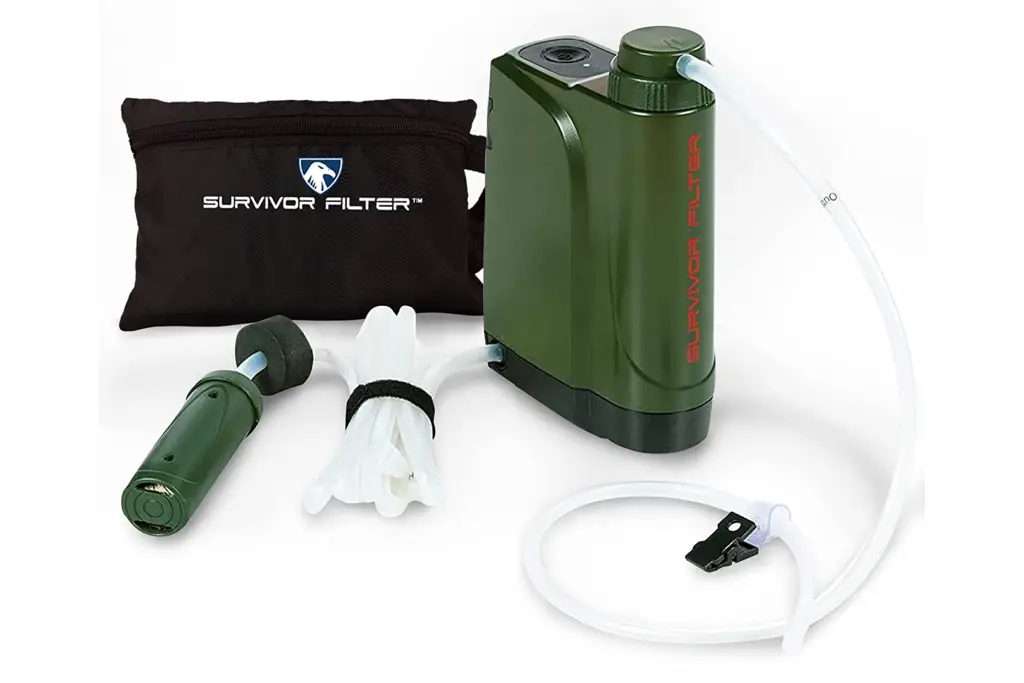
If the worry about filtering out mRNA nanoparticles isn’t of concern, and you’re not ready for a reverse osmosis (OS) system, based on the above particle removal threshold, the Survivor Pro filter offers the best low-volume filtration capability on the market. It comes in both a manual pump and an electric version.
Unfortunately, the system takes more effort to use when compared to a ZeroWater dump-and-pour pitcher or a Berkey. However, it is the best non-RO water filtration system for chemical removal and microplastics, with the Sawyer Tap Filter coming in second.
Nanofiltration – From 0.01 to 0.001 Micron
Nanofiltration is primarily used for softening hard water. Filtration at this level filters out some aqueous salts and dissolved solids, metallic ions, and synthetic dyes.
Reverse Osmosis (RO) – From 0.001 to 0.0001
Considered the most all-around effective way to eliminate contaminants, reverse osmosis can remove dissolved salts, minerals, and metal ions. It also filters out contaminants like lead, heavy metals, and arsenic.
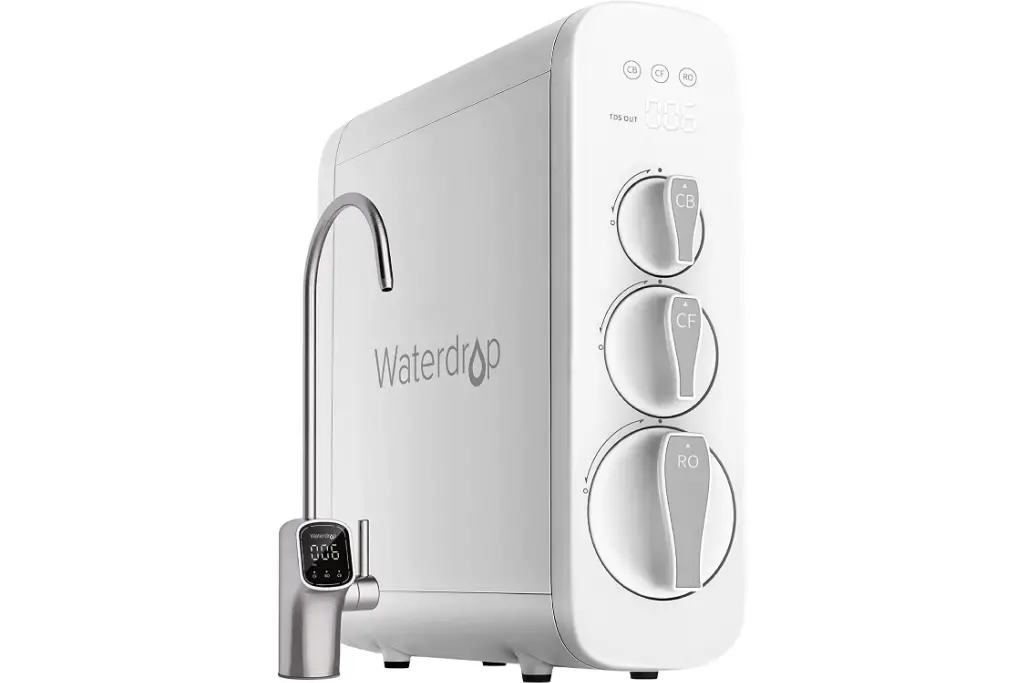
Most importantly, reverse osmosis will remove VOCs (volatile organic compounds) but only if the reverse osmosis system includes a carbon filter, which most do.
Example brand: Waterdrop RO Reverse Osmosis Water Filter
Reverse Osmosis – The Best Method. Period.
While there are numerous products for filtering water, let’s cut right to the chase. At this time, RO is the best method for water filtration available to everyday Americans. Remember, most RO systems also use a high-quality carbon filter as part of the filtration process.
Furthermore, one of the most critical specifications for any purification method is the small threshold for particle removal. RO is the best method for nanofiltration, filtering impurities from 0.001 microns and smaller.
Synthetic mRNA in the Water Supply and God Knows What Else
Like us, you may be worried that mRNA waste is infiltrating the nation’s municipal water supplies. Research shows that mRNA is extremely harmful to the body resulting in vascular and organ damage and even causing death. Unfortunately, at this time, there is little discussion in mainstream outlets about the potential effects of ingesting vaccine waste.
Moreover, research is slowly confirming that dangerous synthetic lipid nanoparticles, synthetic mRNA, and spike proteins are either shedding and/or excreting and/or being released through bodily fluids from those who received mRNA vaccines.
Furthermore, even beyond the bioengineered runoff from “vaccine,” research confirms that our drinking water is full of containments, microplastics, and pharmaceuticals. That’s why it’s imperative to take precautionary measures now. Your health and well-being depend on it.
Spike Protein Detox: Research shows that NAC combined with Bromelain helps break down spike protein.
Reverse Osmosis
With the understanding that reverse osmosis offers the best method for removing chemicals and bioengineered mRNA in water, numerous systems are available. Online you’ll find in-depth discussions about the pros and cons of each. However, below you’ll find a summary of the best products for households, apartments, and travelers.
Best Tankless and Best Overall RO System
Continuously ranked as one of the best reverse osmosis systems, the Waterdrop RO Reverse Osmosis Water Filter is the best option for large households. This simple, tankless system provides water on demand, up to 400 gallons per day.
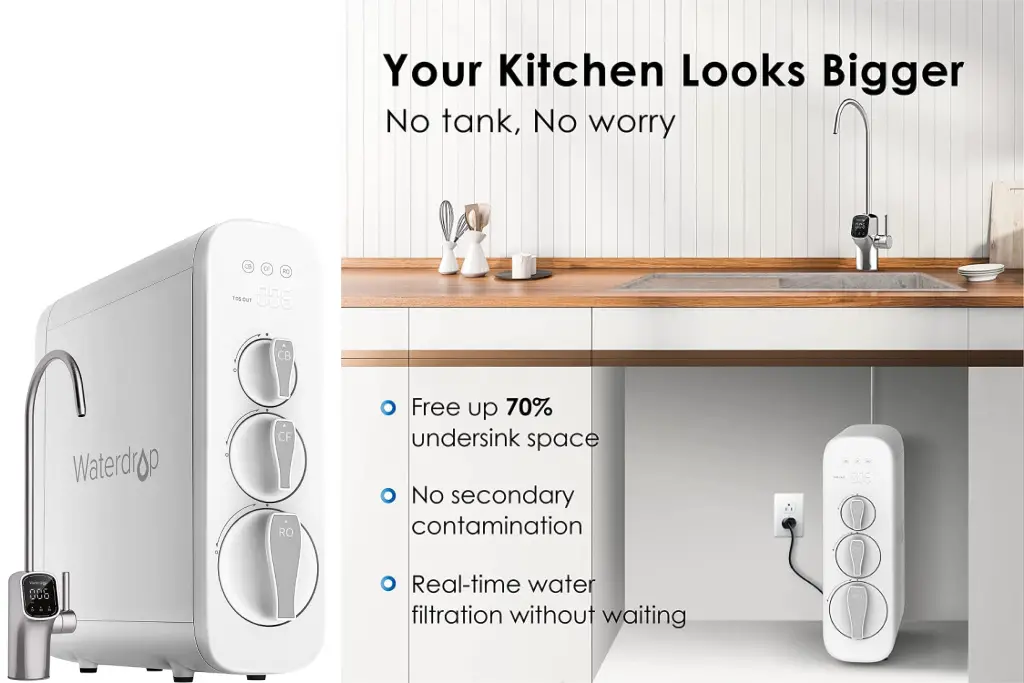
The multi-colored LED display offers the ability to monitor the filters in real-time. With seven filtration steps, the unit is reliable but costly. This RO system is geared toward families who are looking for a hassle-free, quality home system without the need to hire an outside company.
Best Traditional RO System on a Budget
At first glance, the Express Water RO5DX Reverse Osmosis Filtration System appears to be a little overwhelming—but users swear by it as evidenced by its glowing reviews. As one of the cheapest RO systems available, it is made for DIY-ers to install and customize for their home. Its output is 50 gallons per day, removing lead, chromium, arsenic, funky tastes, and odors in five filtration steps.
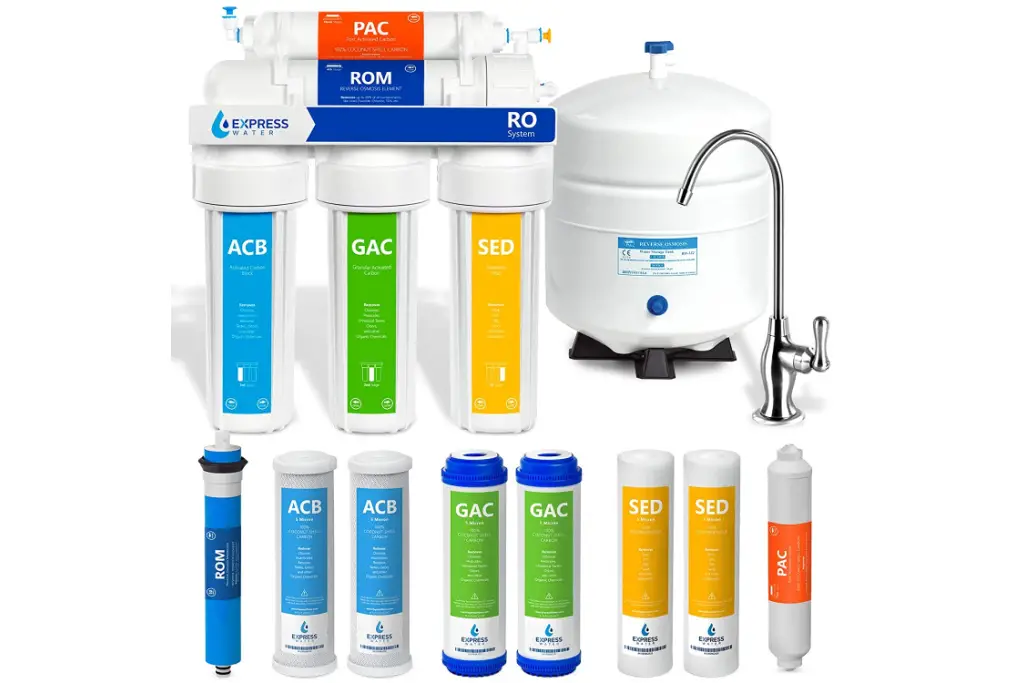
Users appreciate the on-demand support from experts who assist with the installation process. Replacement filters are sold on Amazon, Walmart, and Home Depot. If you purchase a three-year supply of replacement filters, you’ll be set for some time.
Best RO for Countertops, RVs, and Apartments
Thankfully, companies recognize that RO systems need to be more compact. The SimPure Y7P UV Countertop Reverse Osmosis System is a great option for apartments and RVs since it requires no plumbing, drilling, or installation.
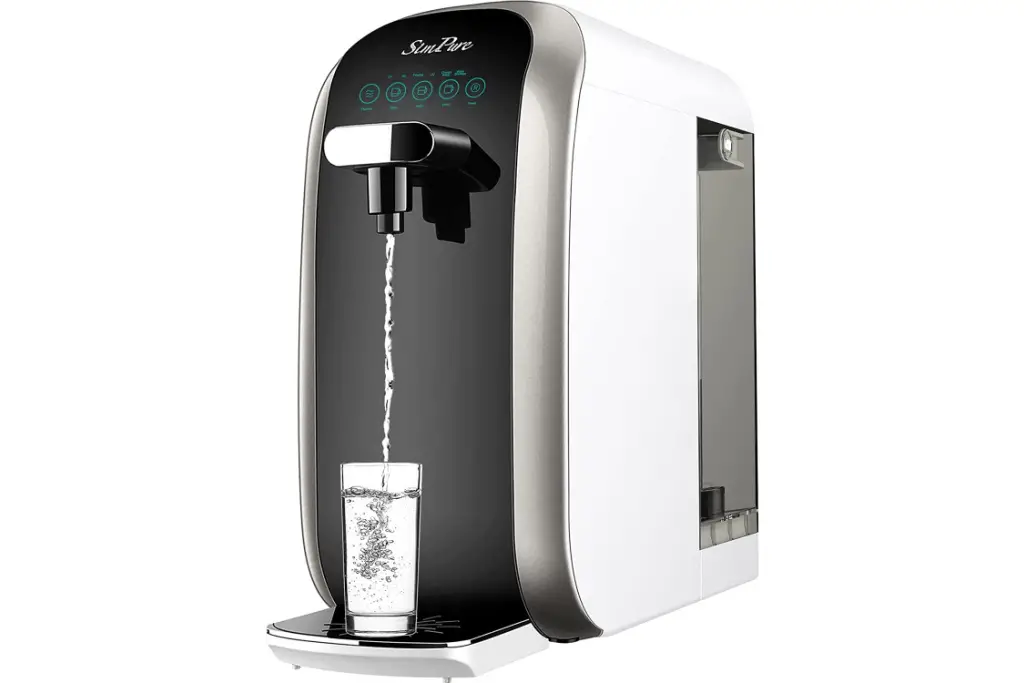
On average, the system lasts about six months before filters need replacing and its pricepoint is the cheapest among all other RO units. Using a three-step filtration method, SimPure is a good option for those who are looking for a more affordable starter system with minimal hassle.
💧 Here’s Our SimPure Countertop Water Filtration System > Buy Now
Best RO System for Drinking Water
A major talking point surrounding RO is how the process filters out healthy minerals that are essential to the human body. For this reason, DIYers who desire perfection may want to explore the Express Water UV Reverse Osmosis Filtration System.
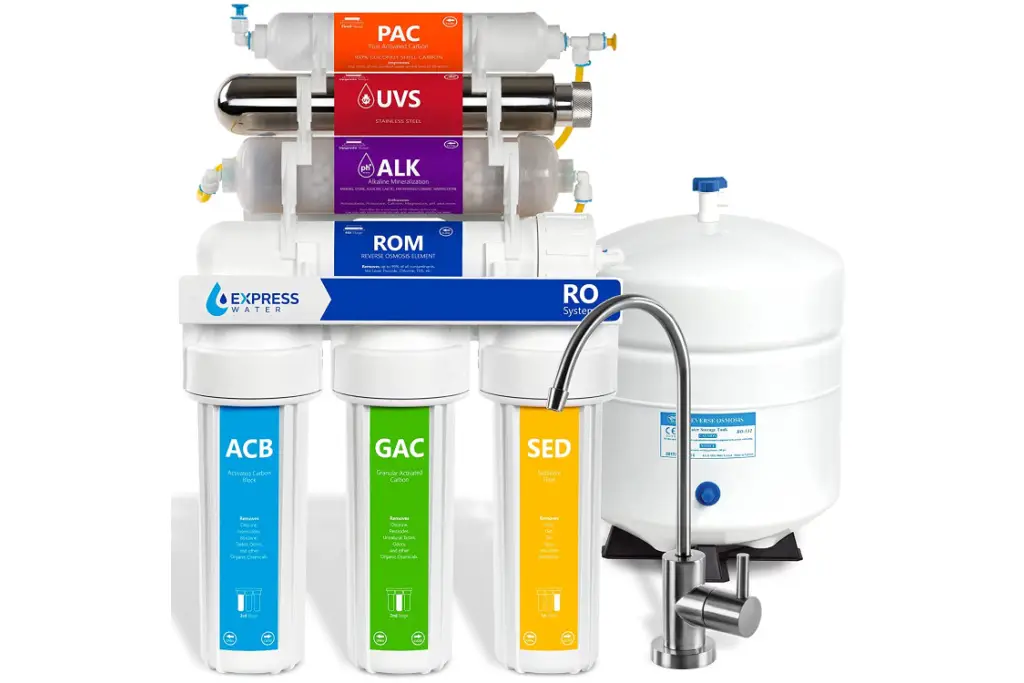
This unit has 11 stages of filtration but also adds the necessary vitamins and minerals back into the water. The result is high-quality drinking water. Take note, while users love the final product there are some setbacks. The unit is very bulky, the filters are costly, and the DIY installation must be done correctly to prevent leaks.
The Fall of Berkey
Researching water filters, it’s surprising to see how many people own and celebrate Berkey water filters. After having access to one during a Tucson Airbnb stay, its popularity is understandable. We left wanting a Berkey system too.
Berkey systems are easy to use, portable, require no electricity, and offer great-tasting water. However, dig deeper and you’ll start seeing some red flags that may change your mind.
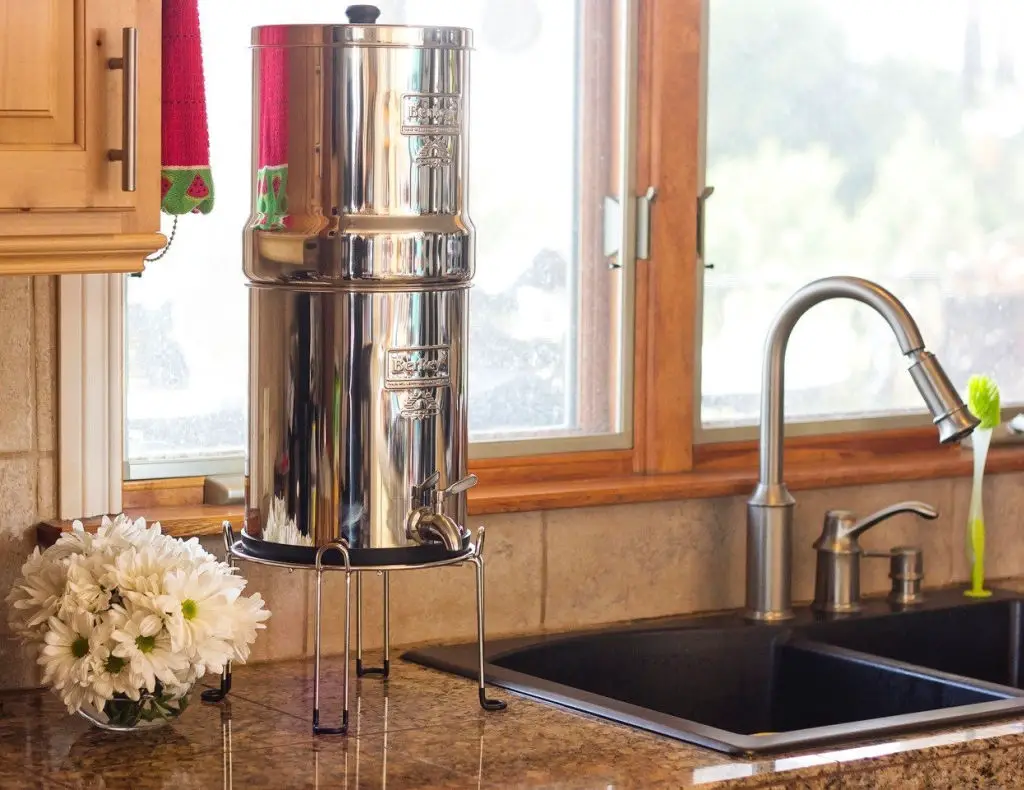
Something Isn’t Adding Up
Berkey has many red flags. First, much of the product line is banned from being sold in California due to their state regulations for lead. Furthermore, it is unclear why Berkey simply won’t complete the third-party testing to allow their products to be sold in California.
If testing would deem the product safe, then what are they trying to hide? California is the most populated state in the country, offering a huge percentage of the population who serve as Berkey’s target customer base.
Next, it’s nearly impossible to identify Berkey’s precise specifications for filtering. Consequently, Berkey is now involved in a class action lawsuit for its false claims about their systems’ water filtration capabilities.
At this time, Berkey loyalists are taking a “let’s wait and see” attitude, however, many are saying where there is smoke there is fire, with too many reports of their water samples failing to meet their purported results. Given the outrageous price of these systems, Berkey’s notoriety has faltered with many refusing to purchase a potentially faulty product.
Distillation
Many people are partial to distilled water. You may notice that distilled water is getting harder and harder to find in stores. This is because the steam distillation process removes most chemicals, contaminants, and bacteria leaving behind cleaner water. The problem with distillation is that it is an extremely slow process and it requires a lot of energy. For example, larger units only distill one-half gallon of drinking water every hour.
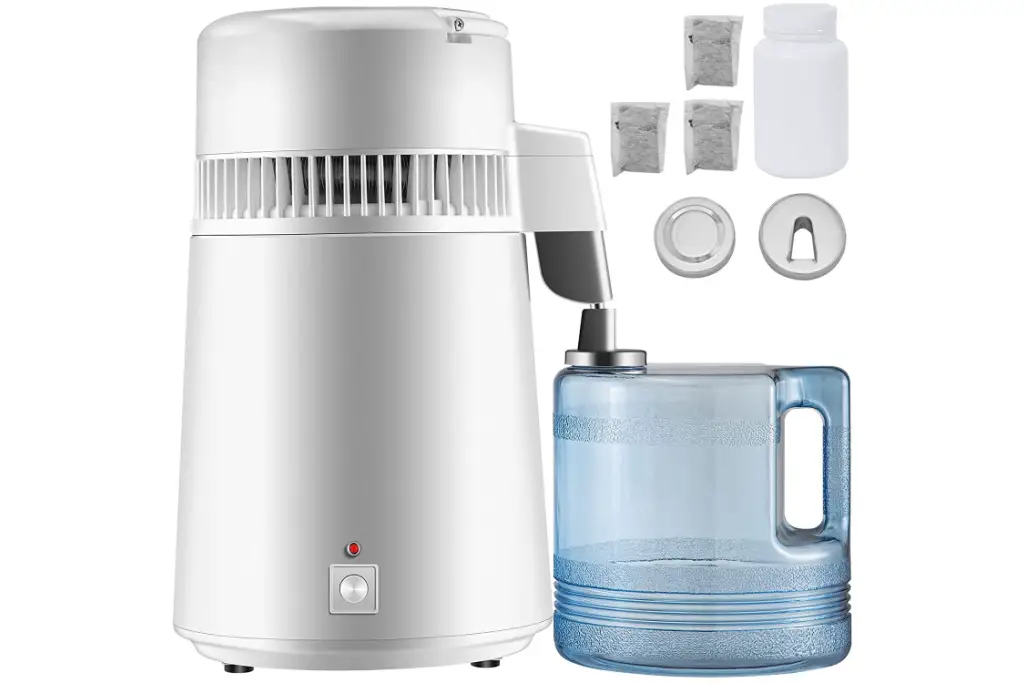
Remember, reverse osmosis and distillation are two different water purification methods. A distillation system cannot remove every trace of chlorine and specific herbicides and pesticides from water. Thus, RO filtration is more effective at purifying water. If you are completely hell-bent on purchasing a distiller consider a stainless steel distiller with a glass carafe. Those on a budget may prefer the Mophorn Water Distiller.
Low-tech Options
In periods of stability, 5-gallon reverse osmosis water jugs are a great option. They are easily purchased at the local grocery store for around $10. Another idea is to purchase packs of Fiji water. Popular with the elite and the immunosuppressed, Fiji water is known to be directly bottled at the source, without ever being exposed to any chemicals or pollutants.
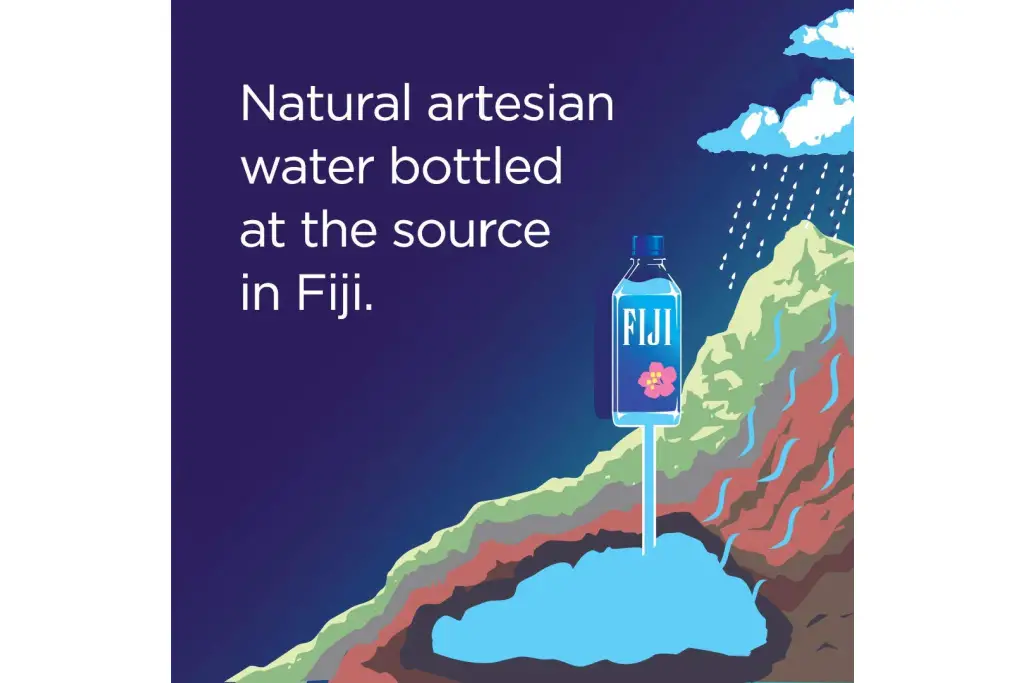
It is important to note that during a time of crisis, such as in the event of a citywide boil order or a natural disaster, it’s important to have an alternative home system available to be prepared at a moment’s notice.
We Need Your Help
Did you find this article helpful? If so, bookmark it and when you’re planning your next vacation, click on any of the links below before finalizing reservations. You’ll get the best price, we’ll earn a small commission, and you’ll help support future articles.
Thank you!
BEST TRAVEL SEARCH ENGINES
🏘️ Book Accommodation
We use Tripadvisor to compare prices and reviews in advance and check availability
✈️ Book Your Flight
To find the cheapest flight options, use Skyscanner to find the most suitable choice for you
🚗 Reserve Rental Car
Use Discover Cars to compare prices and view the largest selection of vehicles

